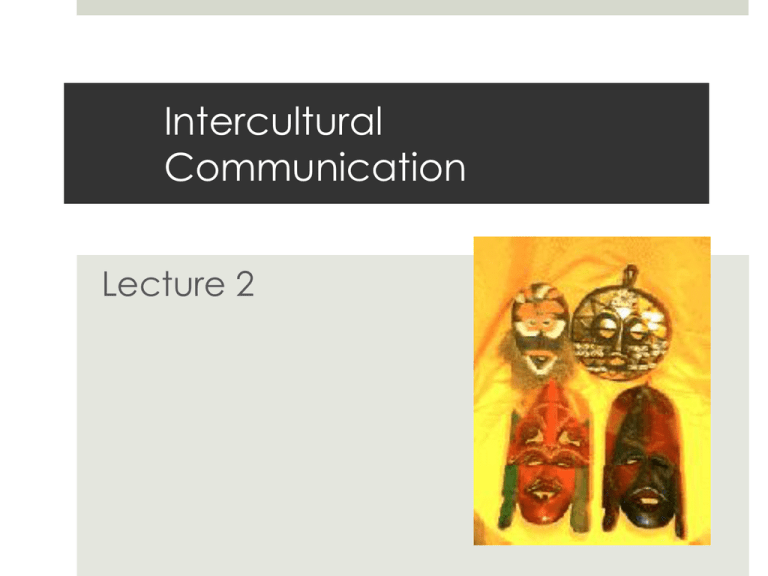Intercultural Communication
advertisement

Intercultural Communication Lecture 2 Review Discourse Systems Based on Ideology (beliefs, values) Relationships Communication patterns Socialization (learning) Can be big or small Multiple Overlapping Discourse Systems Female Youth City U Student Chinese Christian Hong Konger Examples of discourse systems ? ? ? ? ? ? Two types of discourse system Voluntary Goal oriented Involuntary Based on characteristics that are not chosen IMPORTANT POINT Since everyone is simultaneously a member of many discourse systems Interdiscourse communication is NOT ONLY Me-----You BUT ALSO Me----Me----Me My new experience Yoga Combat! Task Watch the video How does this situation constitute interdiscourse communication? The Ambiguity of Language People don’t mean what they say People don’t say what they mean We must draw inferences about meaning Our inferences tend to be fixed, not tentative Our inferences are drawn very quickly The Grammar of Context Two main ways we deal with ambiguity We make inferences based on the words people say and the way that they say them TEXT We make inferences based on the situation CONTEXT What is ‘Grammar’ Grammar is a system of shared expectations about how language should be used in a certain community Grammars which are written down in books are descriptions of how the people who have power use language Different dialects or varieties may have different grammars Where are these people from? My brother really hungry la. Let’s go for makan. I cannae mind the place where those bairns are from. Yo mama so bowlegged, she looks like the bite out of a doughnut. Grammar is a System BAE SAE She very nice She’s very nice He a teacher I run when I bees on my way to school He’s a teacher LV to be omitted I always run when I’m on my way to school be signals repeated action LV can’t be omitted always signals repeated action What’s correct? Speech is correct as long as it follows the system Most people never study the grammar of their own language (learned informally) Nobody follows the system exactly Variation in usage is not ‘wrong’. Usually it has a purpose Markedness Unmarked=the usual way, conforming to the system. Marked=unusual, not conforming to the system. Whether something is unmarked or marked depend on the context. ‘What is it?’ ‘What it be?’ The Grammar of Context Just as language has systems, discourse (language in context) also has systems. language grammars tell you how to arrange words, word endings, etc. context grammars tell you what to say to whom, when and how. GOC is ‘learned’ in the same way language grammar is Shared Expectations People from the same discourse community have shared expectations about how speech situations, events and acts should be arranged. People don’t always follow the system exactly. Like language grammar, we use it as a guide-line to assist us in communication. Grammar of Context Seven Components Scene Key Participants Message form Sequence Co-occurrence Patterns Manifestation Scene Setting Time Place location use of space purpose topic genre Genre A ‘type’ of communication lecture business letter informal conversation novel song TV news report Lecture: Fixed Setting Time: Thursday, 9:30-12:30 Place: B5311 Use of Space: L standing in front, S’s sitting in chairs Purpose: to learn Topic: Intercultural Communication Genres: lecture, small group activities Date: Not as Fixed Time: usually evening Place: cinema, restaurant, park, karaoke Use of space: depends on other components of GOC Purpose: To establish or maintain relationship Topic: Depends on participants Genre: dinner, karaoke, picture-taking Date: Marked Occurrences Time: Thursday, 1:30-4:30 Place: B5311 Use of space: Boy standing in front, girl sitting in chair Purpose: to learn Topic: Intercultural Communication Genre: lecture Time and space Edward T. Hall Famous American Anthropologist Hall, E.T. (1959). The silent language. Garden City, NY: Anchor Press/Doubleday. Hall, E.T. (1977). Beyond culture. Garden City, NY: Anchor Press/Doubleday. Hall, E.T. (1983). The dance of life. Garden City, NY: Anchor Press/Doubleday. Punctuality in Brazil As a visiting professor in Brazil, Levine (1988) discovered that college students there had a very different conception of class time compared to American students. When the time came to meet his first class, Levine arrived twenty minutes late to an empty classroom (Levine & Wolff, 1985). But, unlike in the U.S.A., that did not mean that the class had already been there and left. Rather, it meant that none of the class had even arrived! Then, when class was over, only a few students left. The rest hung around for an additional half hour. Punctuality and Values Levine asked US and Brazilian college students about what makes a successful person US students rated people who were never late for appointments as more successful Brazilians rated people who were always late for appointments as more successful Why? Time Different discourse systems have different concepts of time For some: abstract, measurable, independent of circumstances, synthetic For others: measured in natural cycles (eg. Crops) Chronos (‘clock time’) Kairos (‘appropriate time’) Metaphors for Time Time is money Spend time Waste time Run out of time Save time Lose time Urgency Type ‘A’ personality ‘hurry sickness’ Rural—city Genders Generations Professions Contexts Effect of technology Monochronic vs. Polychronic Orientation towards time Monochronic Polychronic Linear, tangible, divisible Circular, holistic. Flexible Single focus: Events scheduled one item at a time Multiple focus: Simultaneous attention to different things Schedule takes precedence over relationships Greater involvement with people Emphasis on punctuality Adherence to plan Change plans easily Easily distracted ageric vs. non-ageric How does one define being ‘busy’ Thinking vs. Doing Especially important in corporate discourse systems ‘Looking busy’ Variety Related to sense of time passing Boredom Cultural differences Urban-rural Generational Effects of technology Attitudes towards the past and the future ‘Golden Age’ view Utopian view Traditional Chinese/Confucian view Maoist view Contemporary Chinese view Contemporary American view Your view? Your grandparents’ view? Different dimensions of time WHICH ARE YOU? Urgency vs, non-urgency Monochronism vs. polychronism Ageric vs. non-ageric Variety vs. regularity Golden age vs. utopian Use of space Proxemics The Hidden Dimension (1966) human perceptions of space are molded and patterned by culture differing cultural frameworks for defining and organizing space can lead to serious failures of communication and understanding in cross-cultural settings personal spaces that people form around their bodies cultural expectations about how streets, neighborhoods and cities should be properly organized. Use of Space: Business North Americans big boss has the corner office on the top floor, deep carpets, an expensive desk, and handsome accessories. The most successful companies are located in the most prestigious buildings. France the highest-ranking executives sit in the middle of an open area, surrounded by lower-level employees. Middle East fine possessions are reserved for the home, and business is conducted in cramped and modest quarters. Personal Space Intimate space the closest "bubble" of space surrounding a person. Entry into this space is acceptable only for the closest friends and intimates. Social and consultative spaces the spaces in which people feel comfortable conducting routine social interactions with acquaintances as well as strangers. Public space the area of space beyond which people will perceive interactions as impersonal and relatively anonymous. Personal Space According to Hall… In the United States people engaged in conversation will assume a social distance of roughly 4-7’ in many parts of Europe the expected social distance is roughly half that Americans traveling overseas often experience the urgent need to back away from a conversation partner who seems to be getting too close.. Personal Space The distance one keeps with the other person may influence the response one will get If you are too close to a person who is used to keeping a certain physical distance in conversation, this person may feel threatened. If you keep the same distance with a person who is used to physically closer interaction, physical distance may be interpreted as psychological distance. Elevator Rules What are the rules are for standing in the elevator? Which way should you face? Where do people stand when there are only two or three people? What happens when a fourth person enters the elevator. How would you feel if there were two people on the elevator and a third person entered and stood right next to you? What do people look at in a crowded elevator? When is it permissible to talk to the other people? Participants Number Who they are What roles they take Different roles in different situations Performatives: Speech acts which can only be performed by certain people in certain places ‘I now pronounce you husband and wife’ Participants Different discourse systems have different ideas about participant roles Japanese vs. American decision making American vs. Chinese classrooms Chinese: Teacher always introduces topics American: Students often introduce topics Key From music: minor key/major key Mood Key of a Wedding: Happy Key of a Funeral: Sad Key of a Lecture: ? Intercultural Differences laughter = relaxed/ laughter = nervous crying at weddings/dancing at funerals Message Form Speaking Writing Silence Other media Video Overhead projection, slides Amplification Recording ‘The Medium is the Message’ The message form we choose changes the message Breaking up What’s the best way and the worst way to break up and why face to face conversation telephone Letter Email Facebook (relationship status) Weibo or Twitter text message (SMS) instant messaging (MSN) Silence a combination of the above Sequence Set Agenda Open Agenda Conventional Ordering Proposing Marriage Preparation: ‘I have something to talk to you about...’ Reasons: ‘We’ve been going out for a long time...’ Main Point: So, would you like to get married? Sequence Associated with ‘scripts’ McDonald’s script Yum Cha script Western Restaurant script ‘Hey man, don’t eat my shit’ Co-occurrence Patterns Things that usually go together joke--humorous key apology--serious key lecture--lecture theater meeting--set agenda conversation on date--open agenda Manifestation Explicit (rules stated in a very clear way) (often the case in ceremonies) E.g. ‘Please rise’ ‘You may now kiss the bride’ Tacit (rule not stated but understood) Manifestation of GOC is usually tacit So people from different DS’s have problems What’s the GOC in your discourse system for ... Taking your boyfriend home to meet the parents playing mahjong robbing a bank breaking up with a lover ____________________ Task Compare the GOC for a school assembly and a pop music concert Context Hall High vs. low context cultures HC context meaning LC Information High vs. Low Context Low High Most of the meaning in the words Most of the meaning in the context Background information more explicit/verbalized Background information more implicit/tacit Narrower social networks Wider on social networks ‘New couple’ ‘Old couple’ Context and Culture Which of the following countries do you think Hall categorizes as High Context and which as Low Context? (List in order of high to low) France Brazil Japan USA Context and culture While these terms are sometimes useful in describing some aspects of a culture, one can never say a culture is "high" or "low" because societies all contain both modes. "High" and "low" are therefore less relevant as a description of a whole people, and more useful to describe and understand particular situations and environments. Task High or Low Context Situations A meeting of a small religious group A party with friends A sport or game where rules are clearly laid out Eating at a neighborhood restaurant with a regular clientele Taking a flight at an airport Eating at a cafeteria/canteen










